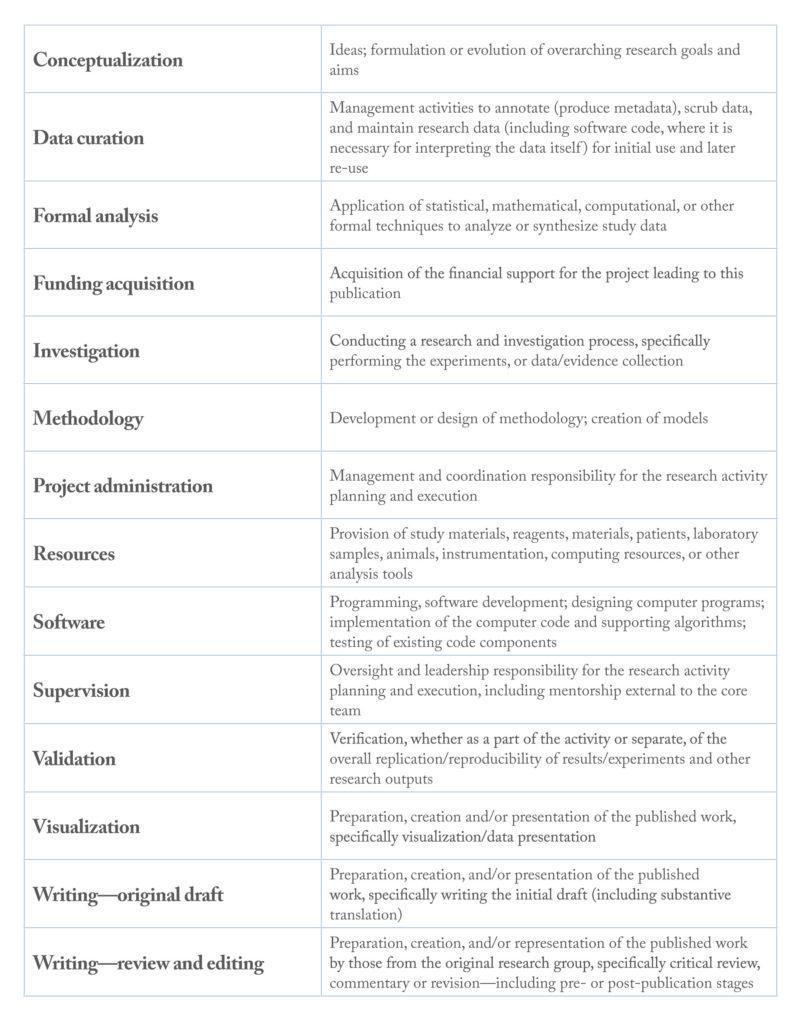Featured
Fully Credited: Making Publishing More Equitable
A new model of “contributorship" addresses the marginalization of early-career researchers in scientific publications.

Scientific authorship norms are outdated. Under current practices, scientists applying for academic positions or research grants are evaluated largely on the quantity and quality of peer-reviewed publications they have authored. These practices can have demonstrable effects on success throughout their careers—for example, co-authorship within the first 3 years of one’s first publication predicts later career success, as measured by citations (Li et al., 2019). Yet despite authorship being the most scrutinized performance metric in a scientist’s career, there’s little (if any) appreciable consideration of the criteria or factors that determine authorship on any given publication. Further, authorship disputes—which typically arise when someone does not receive credit for research contributions (Seeman & House, 2010)—are a prominent ethical issue for the scientific community (Benos et al., 2005). As an early-career researcher and an advocate for open science, I believe it is time to review authorship guidelines and practices to ensure they equitably confer credit to all contributing scientists and align more broadly with the aims of scientific research.
In the absence of the widespread adoption of a standardized framework, current authorship practices promote inequity in the recognition of scientific contributions (Eggert, 2011). Recommendations for authorship criteria exist; most science, technical, and medical journals follow those of the International Committee of Medical Journal Editors (see sidebar). But many lead authors on research projects don’t think to have discussions around authorship until they submit the manuscript.
These criteria often require drafting or revising manuscripts for intellectual content. That is, if the work of a researcher does not involve any writing or editing of the manuscript, that researcher might be left off the ensuing publication—a phenomenon known as “ghost authorship”—despite having been necessary for the completion of the research project (Eggert, 2011). Further, researchers rarely explicitly explain their authorship criteria, instead relying on intuitions about current authorship norms (doing what “seems to be the right thing”; Seeman & House, 2010). Such intuitions, which may be informed by previous experience or departmental training, are widely variable across research labs; contributions recognized as authorship in one lab may not be in another.
Partly because of authorship incentive structures, of most importance to scientists are publications where they are the first author, which typically signifies being the main writer of the manuscript and the lead on the research project. Secondary authorship—indicating a contribution deemed enough to merit recognition—is not readily considered for research grants or academic jobs. This promotes an incentive structure in which scientists actively pursue research projects that will lead to first-author publications rather than pursuing collaborative projects. This model of authorship may have served science well when most publications had only one author (Rennie et al., 1997), but it is outdated today, as science moves from its “hero” model to a diverse collaboration of the efforts of multiple people (Borenstein & Shamoo, 2015).
“Contributorship” is a label for a more equitable system (Rennie et al., 1997) in which any person who made a substantial contribution to a manuscript is listed as a coauthor, regardless of whether their work included writing or editing. Moreover, their contributions are clearly listed on the publication. The most significant ways in which contributorship standards depart from traditional authorship intuitions are in removing any writing requirement and distinctly and explicitly recognizing various technical contributions.
One way to formalize contributorship involves the Contributor Roles Taxonomy (CRediT; Allen et al., 2019; Brand et al., 2015; McNutt et al., 2018; Vasilevsky et al., 2020). Created by a group of biomedical researchers and publishers, CRediT (casrai.org/credit) identifies 14 potential kinds of contributions to a research project, as shown in the table on the next page. The publishers of thousands of scientific journals have adopted it already.
Adopting a standardized contributorship model advances science. The CRediT model is transparent in recognizing contributions that do not require domain-specific expertise (often technical specializations—e.g., scientific programming or data analysis). Having one’s contributions visibly credited in any collaboration produces an incentive that promotes those collaborations, as well as specialization in and development of scientific software and data sets (Holcombe, 2019).
“Contributorship” is a label for a more equitable system in which any person who made a substantial contribution to a manuscript is listed as a coauthor, regardless of whether their work included writing or editing.
Further, the machine-readable quality of the CRediT taxonomy facilitates meta-science by enabling easy gathering of data on research contributions (Allen et al., 2019; Holcombe, 2019). These data provide important insights into many aspects of the research process, including contributions from various groups, revealing potential inequities. Bibliometric analyses have highlighted pervasive gender disparities in authorship (Macaluso et al., 2016; Ni et al., 2021), implying that transparent contributorship models may help improve the representation and visibility of women in scientific publications. Similarly, I believe that contributorship models have many potential benefits for early-career researchers—primarily undergraduate research assistants, graduate students, and postdocs.

Recognition for early-career researchers
Authorship disagreements are prevalent in science. A recent survey of more than 5,500 scientists reported that more than half had experienced disagreements involving author naming or ordering (Ni et al., 2021). Such disagreements, whether about inclusion or position, can be difficult to resolve amicably and are often decided on the basis of power differentials (Faulkes, 2018)—that is, by the lab’s senior researcher or principal investigators, who may have widely varied and vague criteria for what warrants authorship (Patience et al., 2019). When “unwritten rules” of authorship lead to decisions falling on the principal investigators, the decision whether to recognize the contributions of junior scientists with authorship becomes reliant on others’ motivations or the standards set in the research lab. Further, raising disagreements about authorship can lead to perceptions of being ‘entitled’ or ‘difficult,’ deterring researchers from raising such concerns in the first place. Therefore, early-career researchers are vulnerable to unfair authorship decisions (Andes & Mabrouk, 2018).
Without standardized criteria, varying determinants for authorship can also foster inequality across labs. Establishing CRediT or other standards from a project’s outset or as standard lab protocol lends transparency to expectations about authorship and clarifies parameters for resolving disagreements. This is incredibly helpful for junior scientists, such as research assistants or early graduate students, who may be unaware of what warrants authorship. Clear guidelines about authorship may also incentivize and motivate junior scientists to contribute across various roles or refine their research training—for example, to curate data and any experimental or analysis code in addition to collecting data.
Consider this scenario: A principal investigator using an internalized model of authorship may deem a research assistant who completed all the data collection for a research project unworthy of authorship on the paper. The research assistant, who was perhaps not asked to contribute to drafting or revising the manuscript, may then feel unfairly unrecognized. This violation of expectations, even with a successful resolution to the authorship dispute, can bring irreparable damage to a mentorship relationship. By comparison, a contributorship model explicitly and transparently recognizes the research assistant’s contribution.
In addition, junior scientists in their early academic years typically receive research training by helping with data collection and curation, but they seldom do any writing of a manuscript, a necessary criterion for authorship under current norms. This may set a standard from the beginning of a scientist’s training that not all research contributions are recognized (Allen et al., 2019). A large-scale analysis of metadata on PLOS publications by Larivière (2016) found that researchers with less experience (measured as the time since their first publication) were more likely to have contributed technical components of a research paper, such as experimentation, whereas senior researchers typically contributed conceptual components, such as writing. This is another form of ghost authorship, though the exact prevalence of this practice across science is not clear (Gøtzsche et al., 2007; Patience et al., 2019).
Further, conceptualization and other intellectual contributions to research projects are often mistakenly attributed to the senior researcher or principal investigator instead of to early-career researchers. In fact, principal investigators sometimes demand authorship on publications despite contributing little beyond funding acquisition (sometimes referred to as “honorary” authorship).
CRediT in APS Journals
In recent years, Psychological Science, Clinical Psychological Science, and Advances in Methods and Practices in Psychological Science have begun publishing Author Contributions statements to clarify the specific role each author played in producing an article. The statements’ inclusion was intended to address widely held concerns related to transparency and ambiguity in researchers’ contributions. As a result, readers can now see who did what for a particular article.
In 2021, Advances in Methods and Practices in Psychological Science began trialing the adoption of CRediT, a taxonomy of 14 roles—from conceptualization to funding acquisition to data curation—that is used to delineate authors’ individual contributions to a scientific publication. Building on the success of this trial, APS is exploring expanding the adoption of CRediT in its other journals.
Using the CRediT taxonomy would standardize the Author Contributions section within APS journals. It would also allow the outputs and contributions of individual authors to be readily trackable and machine readable. Outside the realm of publishing, CRediT allows institutions and funders to evaluate researchers on the basis of their specific contributions to publications, rather than fuzzier and less reliable indicators such as the impact factors of the journals publishing their work, the perceived prestige of their institution, or the position of their name in author listings.
Greater utility of ‘secondary author’ publications
Authorship in secondary positions currently has untapped utility beyond the recognition of scientists’ work. Given the increasing number of coauthors per published scientific article (Fanelli & Larivière, 2016), the significance of any one person’s contribution may become diluted. Clarifying specific contributions enables early-career researchers to build a portfolio of their work from secondary-author publications, which often are not recognized at all. Consider the specialized forms of data collection required for many research projects, such as measuring electroencephalography or applying transcranial magnetic stimulation. Under the CRediT model, unlike traditional authorship norms, these contributions would be explicitly listed in the ensuing publication. An undergraduate research assistant could then use a publication to support graduate school applications or to demonstrate their training and experience with a data collection method. This could also help graduate students and postdoctoral researchers who specialize in statistical analysis or modeling applied across various domains. A collection of publications indicating formal contributions to analysis could help these researchers show an employer they have the necessary statistical skills. Further, greater incentives to develop specialized skills could help lead to an infrastructure in which scientific progress can advance with the division of labor.
Valuable metadata to inform better research experience
Limited in time and resources, early-career researchers are incentivized to “publish or perish,” but the low value assigned to secondary authorship dissuades them from collaborating within or across research groups. Instead of specializing in a technical skill, they may feel they have to become skilled across all aspects of research projects. Further, technical contributions are least likely to be recognized under current authorship norms, which may be a driving force behind the lack of specialization in science structures. Collaboration between scientists clearly promotes knowledge sharing and increases research efficiency (Katz & Martin, 1997), as evidenced by Many Labs projects—recent large-scale efforts across multiple laboratories to conduct replications. Despite the importance of replications in light of concerns over reproducibility, many researchers’ contributions to these projects are inadequately rewarded or valued.
With scientific research undergoing significant reforms and becoming more collaborative, there is a growing need to understand and recognize contributions across all career levels (Holcombe, 2019). Analyses of the empirical literature like those by Larivière et al. (2016) and Macaluso et al. (2016) would be greatly facilitated and could help inform scientists about future challenges for reforming academic and research structures. Explicitly recognizing all researchers’ contributions with CRediT could facilitate the creation of specialized careers within science (Larivière et al., 2016), address mounting concerns about the imbalance between PhDs awarded and tenure-track academic jobs available (Larson et al., 2014; Sauermann & Roach, 2012), and improve the academic landscape for early-career researchers in the future.
Feedback on this article? Email apsobserver@psychologicalscience.org or scroll down to comment.
References
Allen, L., O’Connell, A., & Kiermer, V. (2019). How can we ensure visibility and diversity in research contributions? How the Contributor Role Taxonomy (CRediT) is helping the shift from authorship to contributorship. Learned Publishing, 32(1), 71–74. https://doi.org/10.1002/leap.1210
Andes, A., & Mabrouk, P. A. (2018). Authorship in undergraduate research partnerships: A really bad tango between undergraduate protégés and graduate student mentors while waiting for Professor Godot. In Credit where credit is due: Respecting authorship and intellectual property (Vol. 1291, pp. 133–158). American Chemical Society. https://doi.org/10.1021/bk-2018-1291.ch013
Benos, D. J., Fabres, J., Farmer, J., Gutierrez, J. P., Hennessy, K., Kosek, D., Lee, J. H., Olteanu, D., Russell, T., & Shaikh, F. (2005). Ethics and scientific publication. Advances in Physiology Education, 29(2), 59–74.
Borenstein, J., & Shamoo, A. E. (2015). Rethinking authorship in the era of collaborative research. Accountability in Research, 22(5), 267–283. https://doi.org/10.1080/08989621.2014.968277
Brand, A., Allen, L., Altman, M., Hlava, M., & Scott, J. (2015). Beyond authorship: Attribution, contribution, collaboration, and credit. Learned Publishing, 28(2), 151–155. https://doi.org/10.1087/20150211
Eggert, L. D. (2011). Best practices for allocating appropriate credit and responsibility to authors of multi-authored articles. Frontiers in Psychology, 2, Article 196. https://doi.org/10.3389/fpsyg.2011.00196
Fanelli, D., & Larivière, V. (2016). Researchers’ individual publication rate has not increased in a century. PLOS ONE, 11(3), e0149504. https://doi.org/10.1371/journal.pone.0149504
Faulkes, Z. (2018). Resolving authorship disputes by mediation and arbitration. Research Integrity and Peer Review, 3(1), Article 12. https://doi.org/10.1186/s41073-018-0057-z
Gøtzsche, P. C., Hróbjartsson, A., Johansen, H. K., Haahr, M. T., Altman, D. G., & Chan, A.-W. (2007). Ghost authorship in industry-initiated randomised trials. PLOS Medicine, 4(1), e19. https://doi.org/10.1371/journal.pmed.0040019
Holcombe, A. O. (2019). Contributorship, not authorship: Use CRediT to indicate who did what. Publications, 7(3), Article 48. https://doi.org/10.3390/publications7030048
Katz, J. S., & Martin, B. R. (1997). What is research collaboration? Research Policy, 26(1), 1–18. https://doi.org/10.1016/S0048-7333(96)00917-1
Larivière, V., Desrochers, N., Macaluso, B., Mongeon, P., Paul-Hus, A., & Sugimoto, C. R. (2016). Contributorship and division of labor in knowledge production. Social Studies of Science, 46(3), 417–435. https://doi.org/10.1177/0306312716650046
Larson, R. C., Ghaffarzadegan, N., & Xue, Y. (2014). Too many PhD graduates or too few academic job openings: The basic reproductive number R0 in academia. Systems Research and Behavioral Science, 31(6), 745–750. https://doi.org/10.1002/sres.2210
Li, W., Aste, T., Caccioli, F., & Livan, G. (2019). Early coauthorship with top scientists predicts success in academic careers. Nature Communications, 10(1), Article 5170. https://doi.org/10.1038/s41467-019-13130-4
Macaluso, B., Larivière, V., Sugimoto, T., & Sugimoto, C. R. (2016). Is science built on the shoulders of women? A study of gender differences in contributorship. Academic Medicine, 91(8), 1136–1142. https://doi.org/10.1097/ACM.0000000000001261
McNutt, M. K., Bradford, M., Drazen, J. M., Hanson, B., Howard, B., Jamieson, K. H., Kiermer, V., Marcus, E., Pope, B. K., Schekman, R., Swaminathan, S., Stang, P. J., & Verma, I. M. (2018). Transparency in authors’ contributions and responsibilities to promote integrity in scientific publication. Proceedings of the National Academy of Sciences, 115(11), 2557–2560. https://doi.org/10.1073/pnas.1715374115
Ni, C., Smith, E., Yuan, H., Larivière, V., & Sugimoto, C. R. (2021). The gendered nature of authorship. Science Advances, 7(36), eabe4639. https://doi.org/10.1126/sciadv.abe4639
Patience, G. S., Galli, F., Patience, P. A., & Boffito, D. C. (2019). Intellectual contributions meriting authorship: Survey results from the top cited authors across all science categories. PLOS ONE, 14(1), e0198117. https://doi.org/10.1371/journal.pone.0198117
Rennie, D., Yank, V., & Emanuel, L. (1997). When authorship fails. A proposal to make contributors accountable. JAMA, 278(7), 579–585. https://doi.org/10.1001/jama.278.7.579
Sauermann, H., & Roach, M. (2012). Science PhD career preferences: Levels, changes, and advisor encouragement. PLOS ONE, 7(5), e36307. https://doi.org/10.1371/journal.pone.0036307
Seeman, J. I., & House, M. C. (2010). Influences on authorship issues: An evaluation of receiving, not receiving, and rejecting credit. Accountability in Research, 17(4), 176–197. https://doi.org/10.1080/08989621.2010.493094
Vasilevsky, N., Hosseini, M., Teplitzky, S., Ilik, V., Mohammadi, E., Schneider, J., Kern, B., Colomb, J., Edmunds, S., Gutzman, K., Himmelstein, D., White, M., Smith, B., O’Keefe, L., Haendel, M., & Holmes, K. (2020). Major challenges on authorship and concept of authorship—Why is something more needed on contributorship? In Manubot. Manubot. https://data2health.github.io/contributorship/





APS regularly opens certain online articles for discussion on our website. Effective February 2021, you must be a logged-in APS member to post comments. By posting a comment, you agree to our Community Guidelines and the display of your profile information, including your name and affiliation. Any opinions, findings, conclusions, or recommendations present in article comments are those of the writers and do not necessarily reflect the views of APS or the article’s author. For more information, please see our Community Guidelines.
Please login with your APS account to comment.